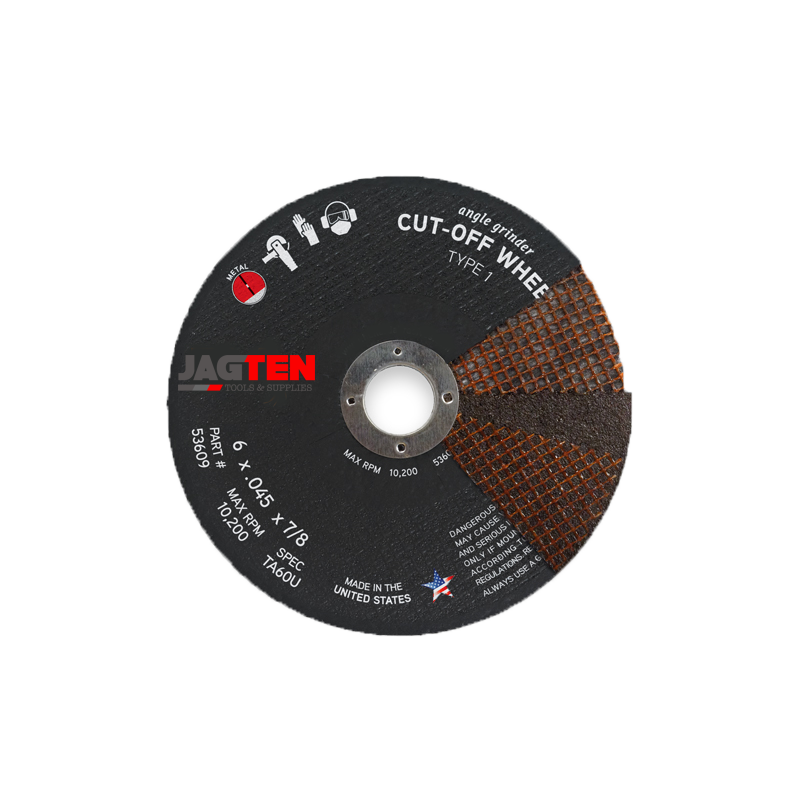Posted by Joe Garcia on Dec 9th 2018
How To Choose The Right Cut Off Wheel For The Job
About 80% of the shops I've walked into use a cut off wheel that was either just laying in the shop, in someone else's toolbox or whatever was on sale! So how do you know your using the right tool for the job? There is a variety of cut-off wheels here is a list of different types:
- Type 1 Small Diameter Cut-Off Wheel
- Type 1 Cut-Off Wheel for Angle Grinders
- Type 27 Cut-Off Wheel for Angle Grinders
Now there is 2 Wheel Types, the first is Type 1 where the wheel is flat and used primarily for cutting see image below.
Type 1

The next is Type 27 which is also used for cutting but can also be used for grinding and notching as it has a depressed center see image below.
Type 27

Small Diameter Cut-Off Wheels come in a variety of different sizes, grains and grits ranging from 2" - 4" in size. Grit range is from 36, 46 and 60 grit and can be found in Ceramic, Zirconia and Treated Aluminum Oxide grains. These wheels are used traditionally on a pneumatic (air) straight shaft air tool or electric cut-off tool. Some companies have engineered newer tools such as this Aircat In-Line Cut-Off Tool.
So how do you choose the right cut-off wheel? How do you know which grit and grain cut-off wheel you are currently using? Well get to that soon on how to read the markings on your wheels. Let's talk about application and choosing the right wheel for your job!
Here's a list of questions you can ask yourself.
- What am I going to cut?
- Is it a ferrous or non-ferrous?
- Do I want minimum burring?
These questions should help you decide the right cut-off wheel for your application.
Let's start with the first question what material are you going to be cutting?
If you are going to be cutting ferrous metals such as welds, steel and Iron. You can use your most common abrasive grain which is Aluminum Oxide and any grit range should suffice for these metals. Aluminum oxide cut-off wheel with 60 and 46 grit are ideal for sheet metal with minimum burring.
A great secondary application for this abrasive grain and grit would be stainless steel and high tensile alloy for fast burr free cutting use 60 girt.
The only exception for non-ferrous metals with Aluminum Oxide would be copper we would recommend a 36 grit cut off wheel.
Stainless steel is treated different than any other metals due to it's properties. For this particular application we would move up to a higher grade abrasive called Zirconia. Zirconia grain cut-off wheel would best be suitable for stainless steel and high tensile as primary application, the wheels typically come in 1/16 and 1/32 thickness with medium (46 grit ) to fine (60 grit).
The next abrasive grain is ceramic, now one of the key components in using a ceramic cut-off wheel is it's contaminate-free cutting of stainless steel. No iron, sulfur or chlorine. It's wheel life is going to be superior to that of any other grain it well outlast aluminum oxide and zirconia wheels. It's designed to cut all forms of stainless steel, high tensile alloys, chrome and Inconel alloys. If your not on a budget and performance is a must a ceramic cut off wheel well surely impress.
So how do you know what you are currently using? The wheels you have should have ANSI identification marker to help identify the wheel below in the image as you can see under "Spec" it has TA60U
TA = Treated Aluminum Oxide
60 = Grit
U= Bond Hardness
Now your wheel might just have an "A'" which means it's just your regular Aluminum Oxide not Treated. Yes, there is different grades of grains we can discuss that topic on another day! To wrap up choosing the right small diameter cut-off wheel here's a snapshot from good, better and best.
- Good - Aluminum Oxide - Primary Application = Welds, Iron and Steel , Secondary = Stainless Steel & High Tensile
- Better - Zirconia - Primary = Stainless Steel and High Tensile Alloy
- Best - Ceramic - Primary = Contaminate Free , Stainless Steel and High Tensile Alloy
- Higher the grit minimum burring.
Small diameter wheels are not made for cutting non-ferrous metals for information on cutting non-ferrous such as Aluminum see part 2 of this blog.



